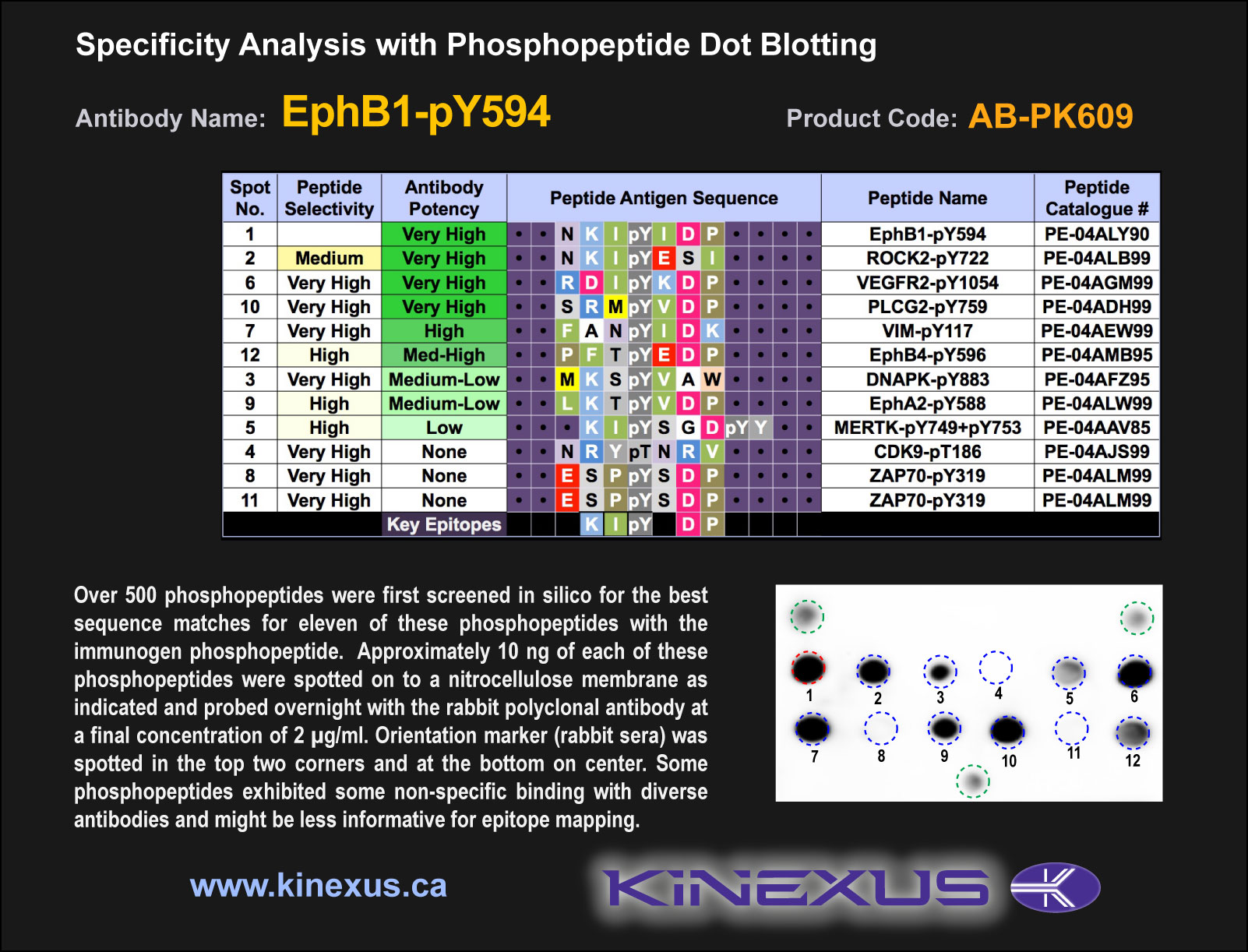Product Name: EphB1-pY594
Product Number: AB-PK609
| Size: | 25 µg | Price: | 89.00 | |
| $US |
Target Full Name: Ephrin type-B receptor 1 protein-tyrosine kinase
Target Alias: AW488255; CEK6; ELK; EPB1; Eph receptor B1; Eph2; EphT2; EPTH2; HEK6; Kinase EphB1; Tyrosine-protein kinase receptor Eph-2
Product Type Specific: Protein kinase phosphosite-specific antibody
Antibody Code: PK609
Antibody Target Type: Phosphosite-specific
Antibody Phosphosite: Y594
Protein UniProt: P54762
Protein SigNET: P54762
Antibody Type: Polyclonal
Antibody Host Species: Rabbit
Target Alias: AW488255; CEK6; ELK; EPB1; Eph receptor B1; Eph2; EphT2; EPTH2; HEK6; Kinase EphB1; Tyrosine-protein kinase receptor Eph-2
Product Type Specific: Protein kinase phosphosite-specific antibody
Antibody Code: PK609
Antibody Target Type: Phosphosite-specific
Antibody Phosphosite: Y594
Protein UniProt: P54762
Protein SigNET: P54762
Antibody Type: Polyclonal
Antibody Host Species: Rabbit
Antibody Immunogen Source: Human EphB1 sequence peptide Cat. No.: PE-04ALY90
Antibody Immunogen Sequence: MKI(pY)IDP(bA)C
Antibody Immunogen Description: Corresponds to amino acid residues M591 to P597; In the region between the transmembrane domain and the kinase catalytic domain. One of the two major in vivo phosphorylation sites in EphB1.
Antibody Immunogen Sequence: MKI(pY)IDP(bA)C
Antibody Immunogen Description: Corresponds to amino acid residues M591 to P597; In the region between the transmembrane domain and the kinase catalytic domain. One of the two major in vivo phosphorylation sites in EphB1.
Production Method: The immunizing peptide was produced by solid phase synthesis on a multipep peptide synthesizer and purified by reverse-phase hplc chromatography. Purity was assessed by analytical hplc and the amino acid sequence confirmed by mass spectrometry analysis. This peptide was coupled to KLH prior to immunization into rabbits. New Zealand White rabbits were subcutaneously injected with KLH-coupled immunizing peptide every 4 weeks for 4 months. The sera from these animals was applied onto an agarose column to which the immunogen peptide was thio-linked. Antibody was eluted from the column with 0.1 M glycine, pH 2.5. Subsequently, the antibody solution was neutralized to pH 7.0 with saturated Tris.This antibody was also subject to negative purification over phosphotyrosine-agarose.
Antibody Modification: Unconjugated. Contact KInexus if you are interest in having the antibody biotinylated or coupled with fluorescent dyes.
Antibody Modification: Unconjugated. Contact KInexus if you are interest in having the antibody biotinylated or coupled with fluorescent dyes.
Antibody Concentration: 1 mg/ml
Storage Buffer: Phosphate buffered saline pH 7.4, 0.05% Thimerasol
Storage Conditions: For long term storage, keep frozen at -40°C or lower. Stock solution can be kept at +4°C for more than 3 months. Avoid repeated freeze-thaw cycles.
Product Use: Western blotting | Antibody microarray
Antibody Dilution Recommended: 2 µg/ml for immunoblotting
Antibody Potency: Strong immunoreactivity with immunogen peptide on dot blots.
Antibody Species Reactivity: Human
Antibody Positive Control: The observed molecular mass of the processed target protein on SDS-PAGE gels is reported to be around 100-105 kDa.
Storage Buffer: Phosphate buffered saline pH 7.4, 0.05% Thimerasol
Storage Conditions: For long term storage, keep frozen at -40°C or lower. Stock solution can be kept at +4°C for more than 3 months. Avoid repeated freeze-thaw cycles.
Product Use: Western blotting | Antibody microarray
Antibody Dilution Recommended: 2 µg/ml for immunoblotting
Antibody Potency: Strong immunoreactivity with immunogen peptide on dot blots.
Antibody Species Reactivity: Human
Antibody Positive Control: The observed molecular mass of the processed target protein on SDS-PAGE gels is reported to be around 100-105 kDa.
Antibody Specificity: Medium-High
Antibody Cross Reactivity: No significant cross-reactive proteins detected in MCF7 and HepG2 cells, except for a very strong ~36 kDa cross-reactive protein in both cell lines and more minor ~75, 52, 27 and 24 kDa cross-reactive proteins.
Related Product 1: EphB1-pY594 blocking peptide
Related Product 2: EphB2-BKCD pan-specific antibody (Cat. No.: AB-NK267-1)
Related Product 3: EphB2-PCT pan-specific antibody (Cat. No.: AB-NK267-2)
Related Product 4: EphB2-pY780 phosphosite-specific antibody (Cat. No.: AB-PK610)
Related Product 5: EphB3-pY600 phosphosite-specific antibody (Cat. No.: AB-PK611)
Antibody Cross Reactivity: No significant cross-reactive proteins detected in MCF7 and HepG2 cells, except for a very strong ~36 kDa cross-reactive protein in both cell lines and more minor ~75, 52, 27 and 24 kDa cross-reactive proteins.
Related Product 1: EphB1-pY594 blocking peptide
Related Product 2: EphB2-BKCD pan-specific antibody (Cat. No.: AB-NK267-1)
Related Product 3: EphB2-PCT pan-specific antibody (Cat. No.: AB-NK267-2)
Related Product 4: EphB2-pY780 phosphosite-specific antibody (Cat. No.: AB-PK610)
Related Product 5: EphB3-pY600 phosphosite-specific antibody (Cat. No.: AB-PK611)
Scientific Background: EphB1 is a protein-tyrosine kinase of the TK group and Eph family. It is a receptor kinase that mediates cell contact signalling via binding Ephrin B family (EFNB1, EFNB2 and EFNB3) of ligands. Phosphorylation at Y594 induces interaction with Nck1 and the SH2 domain of Grb10. Phosphorylation at Y928 induces interaction with Grb2 and Grb7. Interaction with Shc1 and Src involves Y600 phosphorylation, and Shc1binding also occurs with Y778 phosphorylation. EphB1controls neuronal cell development through mediating axon guidance. It also controls chemotaxis, proliferation, and polarity of hippocampal neuronal progenitor cells. The SH2 domain of GRB10 cannot bind EphB1 with an Y928F mutation. EphB1 has been linked with the development of gastric adenocarcinomas and ovarian undifferentiated carcinoma.
© Kinexus Bioinformatics Corporation 2017


